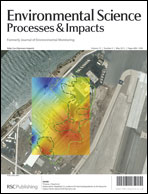The present research was aimed at assessing the quality of air and soil on the premises and in the vicinity of the municipal landfill sites in Toruń with regard to the presence of pathogenic bacteria, potentially dangerous to humans. Air samples (the impaction method using a MAS-100 impactor) and soil samples were collected from seven sampling sites including the operating and closed landfill cells, sampling sites located near leachate ponds, and sampling sites located outside the above premises. The research also involved assessing microbial air contamination in three indoor spaces on the premises of the landfill sites. Microbial tests involved the determination of the number of culturable mesophilic, mannitol-positive, and α- and β-hemolytic bacteria in the air, determination of the number of coliform bacteria, spore-forming Clostridium perfringens in soil, and the presence of Salmonella in soil. The results indicate that bioaerosol emitted by this municipal facility is the source of hemolytic bacteria (≤300 CFU m−3 of air), as well as of pathogenic bacteria (Pseudomonas aeruginosa and Bacillus subtilis). The highest risk of exposure to biological agents was determined in the sorting facility. Over sixty percent of air samples in this sampling site presented high pollution degree with mesophilic bacteria (500–2000 CFU m−3 of air) and over one fourth of air samples presented very high pollution degree (>2000 CFU m−3 of air). Indoor air in other rooms was considered highly/moderately contaminated (100–2000 CFU m−3 of air). The highest risk related to the presence of Salmonella, Clostridium perfringens, and coliform bacteria in soil was determined at the operating landfill cell and near the leachate pond of the closed landfill cell. At the operating landfill cell the total coli ranged from 4–1226 MPN g−1 of dry mass of soil and Clostridium perfringens ranged from <LOD-1604 CFU g−1 of dry mass of soil. The results question the strategy of municipal landfill sites in densely populated areas, and emphasize the need for regular monitoring of microbiological tests in their vicinity as well as for control strategies in order to protect workers at landfill sites. The results of the study should be used for future decisions on the location of municipal landfill sites and suggest the need for better environmental control technologies in the sites that are already functioning.

You have access to this article
 Please wait while we load your content...
Something went wrong. Try again?
Please wait while we load your content...
Something went wrong. Try again?


 Please wait while we load your content...
Please wait while we load your content...